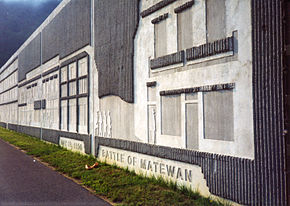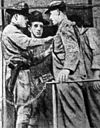- Battle of Matewan
-
Battle of Matewan Date May 19, 1920 Location Matewan, West Virginia, United States Result A setback of Miners' rights until early 1930's when the Government finally recognized American labor unions that eventually led to the passage of the National Industrial Recovery Act (NIRA) of 1933 Belligerents The People of Matewan Baldwin-Felts Detective Agency Commanders and leaders Sid Hatfield
Mayor Cabell Testerman†Albert Felts† Strength Deputy Fred Burgraff and a group of local miners and residents 13 Baldwin-Felts Detectives Casualties and losses 3 killed; 2 Miners and Mayor Cabell Testerman 7 killed; including 2 Baldwin-Felts Detectives brothers Albert and Lee Felts The Battle of Matewan (also known as the Matewan Massacre) was a shootout in the town of Matewan, West Virginia in Mingo County on May 19, 1920 between local miners and the Baldwin-Felts Detective Agency.
A contingent of the Baldwin-Felts Detective Agency arrived on the no. 29 morning train in order to evict families that had been living at the Stone Mountain Coal Camp just on the outskirts of town. The detectives carried out several evictions before they ate dinner at the Urias Hotel and, upon finishing, they walked to the train depot to catch the five o'clock train back to Bluefield, West Virginia. This is when Matewan Chief of Police Sid Hatfield decided that enough was enough, and intervened on behalf of the evicted families. Hatfield, a native of the Tug River Valley, was an adamant supporter of the miners' futile attempts to organize the UMWA in the saturated southern coalfields of West Virginia. While the detectives made their way to the train depot, they were intercepted by Hatfield, who claimed to have arrest warrants from the Mingo County sheriff. Detective Albert Felts and his brother Lee Felts then produced his own warrant for Sid Hatfield's arrest. Upon inspection, Matewan mayor Cabell Testerman claimed it was fraudulent. Unbeknownst to the detectives, they had been surrounded by armed miners, who watched intently from the windows, doorways, and roofs of the businesses that lined Mate Street. Stories vary as to who actually fired the first shot; only unconfirmed rumors exist. Thus, on the porch of the Chambers Hardware Store, began the clash that became known as the Matewan Massacre, or the Battle of Matewan. The ensuing gun battle left seven detectives and four townspeople dead, including the Felts brothers and Testerman. The battle was hailed by miners and working class members for the number of casualties inflicted on the Baldwin-Felts detectives. This tragedy, along with events such as the Ludlow Massacre in Colorado six years earlier, marked an important turning point in the battle for miners’ rights.
Contents
History
At the time, the United Mine Workers of America had just elected John L. Lewis as their president. During this period, miners worked long hours in unsafe and dismal working conditions, while being paid low wages. Adding to the dilemma was the use of company scrip by the Stone Mountain Coal Company, because the scrip could only be used for those goods the company sold through their company stores, thus the miners did not have actual money that could be used elsewhere. A few months before the battle at Matewan, union miners in other parts of the country went on strike, receiving a full 27 percent pay increase for their efforts. Lewis recognized that the area was ripe for change, and planned to organize the coal fields of southern Appalachia. The union sent its top organizers, including the famous Mary Harris "Mother" Jones.[1] Roughly 3000 men signed the union’s roster in the Spring of 1920. They signed their union cards at the community church, something that they knew could cost them their jobs, and in many cases their homes. The coal companies controlled many aspects of the miners' lives.[2] Stone Mountain Coal Corporation fought back with mass firings, harassment, and evictions.[3]
The Town of Matewan
Matewan, founded in 1895, was a small independent town with only a few elected officials. The mayor at the time was Cabell Testerman, and the chief of police was Sid Hatfield. Both refused to succumb to the company's plans, and sided with the miners. In turn, the Stone Mountain Coal Corporation hired their own enforcers, the Baldwin-Felts Detective Agency, dubbed the “Baldwin Thugs” by the coal miners. The Baldwin-Felts Detectives had earned a reputation for their brutality. The coal operators hired them to evict the miners and their families from the company owned houses.[4] As a result, hundreds of miner families spent that spring in tents.
The Battle of Matewan
On the day of the fight, a group of the Baldwin-Felts enforcers arrived to evict families living at the mountain coal camp, just outside of Matewan. The sheriff and his deputy, Fred Burgraff, sensed trouble and met the Baldwin-Felts detectives at the train station. News of the evictions soon spread around the town. When Sid Hatfield approached Mr. Felts, Mr. Felts served a warrant on Sid Hatfield, which had been issued by Squire R. M. Stafford, a Justice of the Peace of Magnolia District, Mingo County, West Virginia, for the arrest of Sid Hatfield, Bas Ball, Tony Webb and others, which warrant was directed to Albert C. Felts for execution. The warrant turned out to be fraudulent. Burgraff's son reports that the detectives had sub-machine guns with them in their suitcases. Sid Hatfield, Fred Burgraff, and Mayor Cabell Testerman met with the detectives on the porch of the Chambers Hardware Store. It is still unknown whether it was Hatfield or the leading detective, Albert Felts, that shot Mayor Testerman first, though what followed was Sid Hatfield shooting Albert Felts. There are rumors that Sid shot Mayor Testerman because he had feelings for his wife, but they were never confirmed, although he did remarry her after Mayor Testerman's death. After the detective and mayor fell wounded, Sid kept firing, but Felts escaped. He took shelter in the Matewan Post Office, and Hatfield eventually found him there and shot him. When the shooting finally stopped, the townspeople came out, many wounded. There were casualties on both sides. Seven Baldwin-Felts Detectives were killed, including brothers Albert and Lee Felts. One more detective had been wounded. Two miners were killed, Bob Mullins, who had just been fired for joining the union, and Tot Tinsley, an unarmed bystander. The wounded mayor was dying, and four other bystanders had been wounded.
Aftermath
Governor John J. Cornwell ordered the state police force to take control of Matewan. Hatfield and his men cooperated, and stacked their arms inside the hardware store. The miners, encouraged by their success in getting the Baldwin-Felts detectives out of Matewan, improved their efforts to organize. On July 1 the miners' union went on another strike, and widespread violence erupted. Railroad cars were blown up, and strikers were beaten and left to die by the side of the road. Tom Felts, the last remaining Felts brother, planned on avenging his brothers’ deaths by sending undercover operatives to collect evidence to convict Sid Hatfield and his men. When the charges against Hatfield, and 22 other people, for the murder of Albert Felts were dismissed, Baldwin-Felts detectives assassinated Hatfield and his deputy Ed Chambers on August 1, 1921, on the steps of the McDowell County Courthouse located in Welch, West Virginia.[5] Of those defendants whose charges were not dismissed, all were acquitted. Less than a month later, miners from the state gathered in Charleston. They were even more determined to organize the southern coal fields, and began the march to Logan County. Thousands of miners joined them along the way, culminating in what was to become known as the Battle of Blair Mountain.
See also
- Anti-union violence
- Labor spies
- Matewan the 1987 John Sayles Movie
- Terror of the Tug - a 1980 play written by Jean Battlo
References
- ^ The Autobiography of Mother Jones. Chicago: Charles H. Kerr & Col, 1925.
- ^ http://www.matewan.com/History/battle2.htm
- ^ http://www.wvculture.org/history/labor/matewan04.html
- ^ http://www.montgomerycollege.edu/Departments/hpolscrv/knowlandl.html
- ^ Kilkeary, Desmond. "The Hatfields and the Baldwin-Felts." Chaparral. May 2005.
External links
- The Battle of Matewan
- Official Matewan, WV Website at Matewan.com
- Official Matewan, WV Tourism Website at VisitMatewan.com
- Police Chief Hatfield's memorial
- Matewan Massacre. May 19th, 1920.
Major Armed Conflicts in American Labor Union History 19th Century Great Railroad Strike of 1877 · Rock Springs massacre, 1885 · Bay View Massacre, 1886 · Haymarket affair, 1886 · Thibodaux massacre, 1887 · Homestead Strike, 1892 · Coeur d'Alene, Idaho labor strike of 1892 · Pullman Strike, 1894 · Streetcar strikes in the United States, 1895-1929 · Lattimer massacre, 1897 · Battle of Virden, 189820th Century Streetcar strikes in the United States, 1895-1929 · Colorado Labor Wars, 1903-1904 · 1905 Chicago Teamsters' strike · Pressed Steel Car Strike of 1909 · Westmoreland County Coal Strike of 1910–1911 · Paint Creek-Cabin Creek strike of 1912 · Ludlow Massacre, 1914 · Everett massacre, 1916 · Bisbee Deportation, 1917 · 1920 Alabama coal strike · Battle of Matewan, 1920 · Battle of Blair Mountain, 1921 · Herrin massacre, 1922 · Columbine Mine massacre, 1927 · Auto-Lite strike, 1934 · 1934 West Coast waterfront strike · Memorial Day massacre of 1937 Portal:Organized LabourCategories:
Portal:Organized LabourCategories:- History of West Virginia
- Miners' labor disputes
- Political repression in the United States
- Mingo County, West Virginia
- 1920 in West Virginia
Wikimedia Foundation. 2010.



